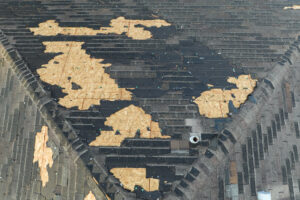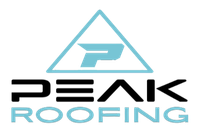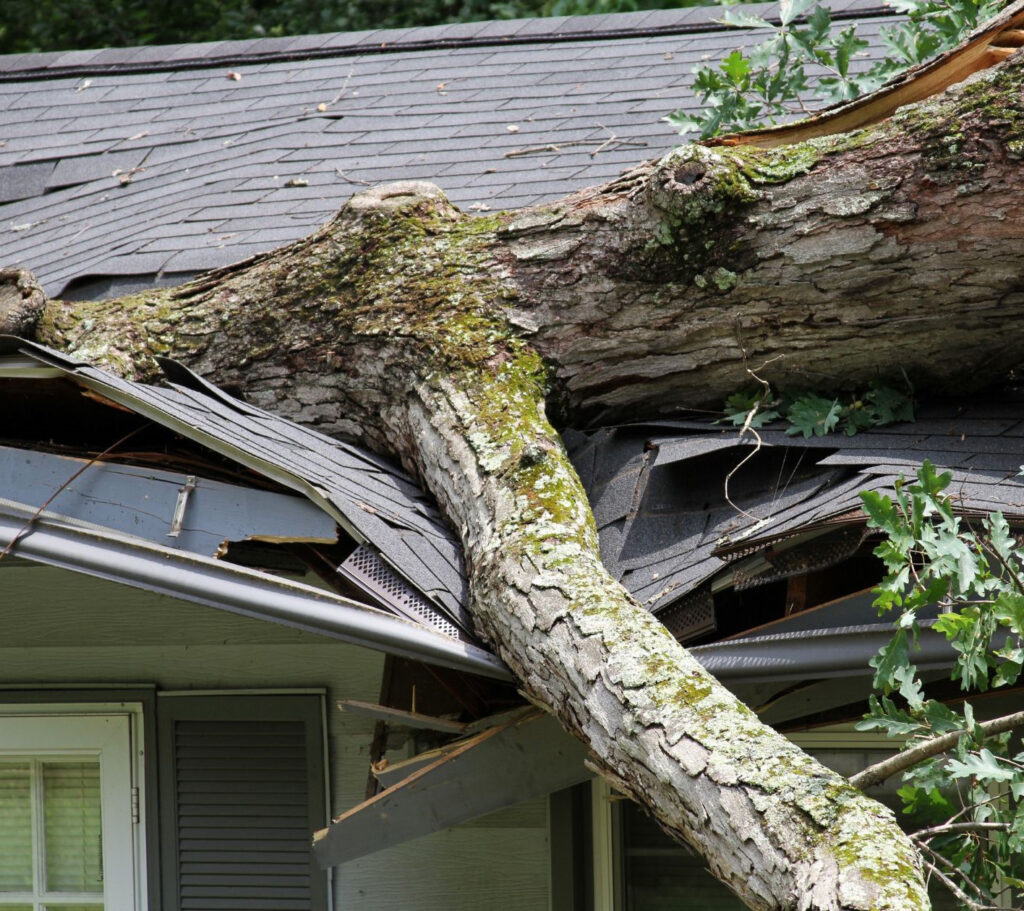 A sturdy roof is crucial for protecting your home from the elements, yet it’s constantly subjected to various natural forces that can lead to deterioration and damage. Whether you’re a homeowner or a roofing contractor, being aware of these factors is essential for maintaining the integrity of your roof. Here we will present 10 natural factors that can significantly damage your roof.
A sturdy roof is crucial for protecting your home from the elements, yet it’s constantly subjected to various natural forces that can lead to deterioration and damage. Whether you’re a homeowner or a roofing contractor, being aware of these factors is essential for maintaining the integrity of your roof. Here we will present 10 natural factors that can significantly damage your roof.
1. Hailstorms – Damage Your Roof
Hailstorms are a formidable threat to roofs, causing immediate and often severe damage. When hailstones strike, they can leave behind dents, punctures, and granule loss, which weaken shingles and shorten the roof’s lifespan. Northwest Arkansas roofers often recommend impact-resistant materials to better withstand such harsh conditions. Hail damage is not always visible from the ground, making professional inspections crucial after a storm. Additionally, the severity of hail damage can vary depending on factors such as the size and speed of the hailstones, as well as the age and condition of the roof.
2. Heavy Rainfall
Heavy rainfall can pose significant challenges to roofs, particularly when gutters and downspouts are not functioning properly. Clogged or damaged gutters can cause water to pool on the roof, leading to leaks and water damage. Roof contractors often emphasize the importance of proper drainage systems to prevent water from seeping under shingles and causing structural issues. Regular inspections and cleaning of drainage systems are essential to efficient operation.
3. High Winds
High winds are notorious for causing significant damage to roofs by lifting and tearing away shingles. This damage exposes the underlying roof structure to the elements, increasing the risk of leaks and further deterioration. Wind damage is particularly concerning in hurricane-prone areas, where roofs must withstand extreme gusts. Reinforcing roof edges and ensuring shingles are properly secured can mitigate wind-related damage. Wind can also carry debris, such as branches and leaves, causing further damage. Regularly trimming overhanging trees and inspecting the roof after storms are essential preventive measures. Homeowners should also consider roofing designs and materials specifically engineered to withstand high winds, which can offer enhanced protection in vulnerable areas.
4. Snow and Ice
Snow and ice accumulation on roofs can create a variety of problems, including ice dams. Ice dams form when snow melts, and the water refreezes at the roof’s edge, preventing proper drainage. This trapped water can seep under shingles and cause leaks. Proper insulation and ventilation are critical in preventing ice dams by maintaining a consistent roof temperature. The weight of snow and ice can strain a roof, leading to structural damage or collapse in extreme cases. Homeowners often consider installing snow guards and heating cables to aid in managing snow and ice on roofs.
5. Ultraviolet (UV) Radiation
Ultraviolet (UV) radiation from the sun can significantly degrade roofing materials over time. Prolonged exposure to sunlight can cause shingles to dry out, crack, and lose their protective granules. This not only diminishes the roof’s aesthetic appeal but also reduces its ability to protect against water intrusion. Routine inspections and maintenance can help identify early signs of UV damage, allowing homeowners to take corrective action before the damage becomes severe. Choosing UV-resistant roofing materials can extend the life of a roof.
6. Temperature Fluctuations
Rapid temperature fluctuations can put stress on roofing materials, causing them to expand and contract. This repeated cycle can lead to cracking, warping, and the formation of gaps where water can infiltrate. In regions with significant temperature variations between day and night, such as desert areas, roofs are particularly susceptible to this type of damage. Understanding the local climate and working with Professional roofers to select appropriate materials are key steps in protecting roofs from temperature-related stress.
7. Moisture and Humidity
High levels of moisture and humidity can create a conducive environment for the growth of mold, mildew, and algae on roofs. These organisms can deteriorate roofing materials, leading to leaks and structural damage. Areas with frequent rainfall or high humidity, such as coastal regions, require extra attention to prevent moisture-related issues. Implementing proper ventilation and using roofing materials with anti-fungal properties can help combat moisture damage. Regular inspections and cleaning to remove debris and organic matter are also essential for maintaining a healthy roof.
8. Tree Branches and Debris
Overhanging tree branches can cause considerable damage to roofs, especially during storms or high winds. Branches that scrape against the roof can wear down shingles and protective layers, while fallen branches can cause immediate and severe damage. Peak Roofing, a company well-versed in handling such issues, recommends regular trimming of nearby trees to prevent branches from coming into contact with the roof. Additionally, debris such as leaves and twigs can accumulate in gutters and on the roof surface, leading to clogs and water retention.
9. Lightning Strikes
Lightning strikes, though rare, can have devastating effects on roofs. A direct strike can cause fires, electrical damage, and structural harm. Even indirect strikes can create power surges that affect a home’s electrical systems. Installing lightning rods and grounding systems can protect roofs from the destructive forces of lightning. Homeowners should also consider using roofing materials with fire-resistant properties to minimize damage in the event of a lightning strike. After a severe storm, it’s essential to inspect the roof for any signs of damage. Being prepared for this unpredictable threat can safeguard both the roof and the home.
10. Pests and Wildlife
Pests and wildlife, such as birds, squirrels, and insects, can cause significant damage to roofs. Birds often build nests in gutters and vents, obstructing airflow and drainage. Squirrels and other small animals can gnaw on roofing materials, creating entry points for water and other pests. Preventing pest-related damage involves regular roof inspections and securing any potential entry points. Using deterrents, such as mesh screens on vents, can help repel pests. Addressing pest issues promptly can prevent minor damage from escalating into more significant problems, ensuring the longevity and integrity of the roof.
Understanding these ten natural factors that can damage roofs is crucial for homeowners seeking to maintain their roofs’ health and longevity. Regular maintenance, professional inspections, and choosing appropriate materials are key strategies for mitigating these risks and ensuring a durable, resilient roof.
Storms Damage Your Roof? – Choose Peak Roofing
Choosing Peak Roofing ensures expert craftsmanship, quality materials, and long-lasting protection for your home. When storms, aging, or improper maintenance damage your roof, our skilled team provides fast, reliable solutions to restore its strength and durability. Ignoring issues can further damage your roof, leading to costly repairs and potential structural problems. With over 60 years of combined experience, we specialize in roof repairs, replacements, and inspections, ensuring your home stays protected year-round. We also offer transparent pricing, strong warranties, and exceptional customer service. Trust Peak Roofing for expert roofing solutions that safeguard your home and provide peace of mind!
Peak Roofing & Exteriors
If you’re looking for an honest and experienced roofing contractor that can handle your home or business roofing needs in West Texas, look no further. Peak Roofing & Exteriors will deliver with quality and integrity. Contact us today and book your FREE inspection!

